Scientific name Pepsini | Phylum Arthropoda Family Pompilidae Rank Tribe | |
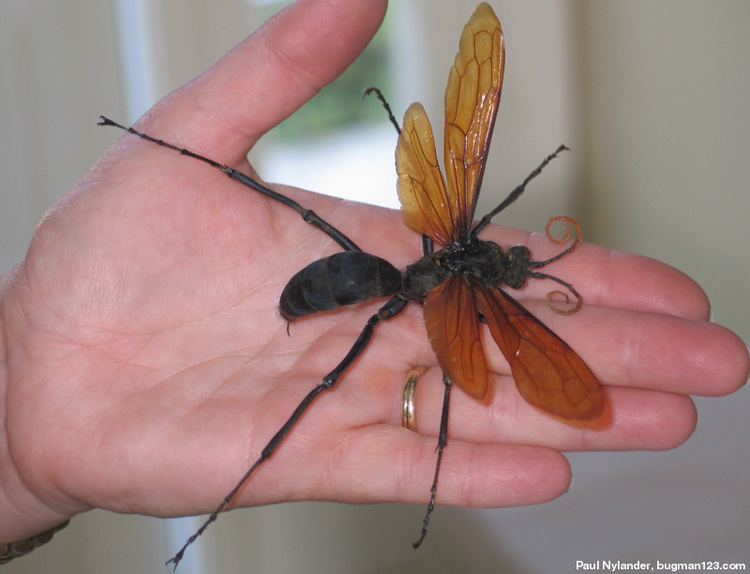 | ||
Similar spider wasp, Tarantula, bullet ant, Goliath birdeater, Velvet ants | ||
Stung by a tarantula hawk
A tarantula hawk is a spider wasp that hunts tarantulas. Tarantula hawks belong to any of the many species in the genera Pepsis and Hemipepsis, in the family Pompilidae (spider wasps).
Contents
- Stung by a tarantula hawk
- Tarantula hawk vs tarantula
- Behavior
- Distribution
- Sting
- State insect of New Mexico
- References
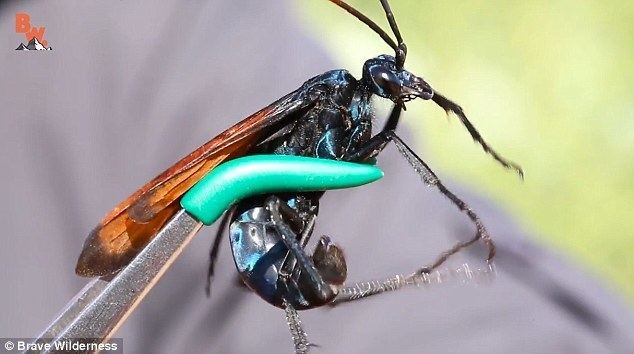
The more familiar species are up to 5 cm (2.0 in) long, making them among the largest of wasps, and have blue-black bodies and bright, rust-colored wings (other species have black wings with blue highlights). The vivid coloration found on the bodies, and especially wings, of these wasps is an aposematism, advertising to potential predators the wasps' ability to deliver a powerful sting. Their long legs have hooked claws for grappling with their victims. The stinger of a female Pepsis grossa can be up to 7 mm (1⁄4 in) long, and the sting is considered the third most painful insect sting in the world, behind only that of the bullet ant and the Warrior wasp.
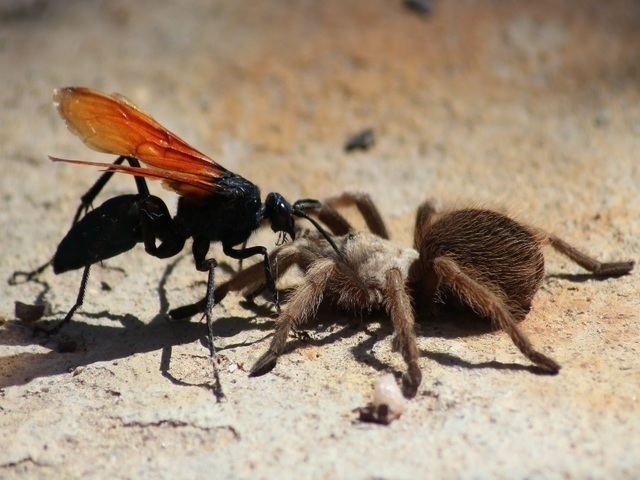
Tarantula hawk vs tarantula
Behavior
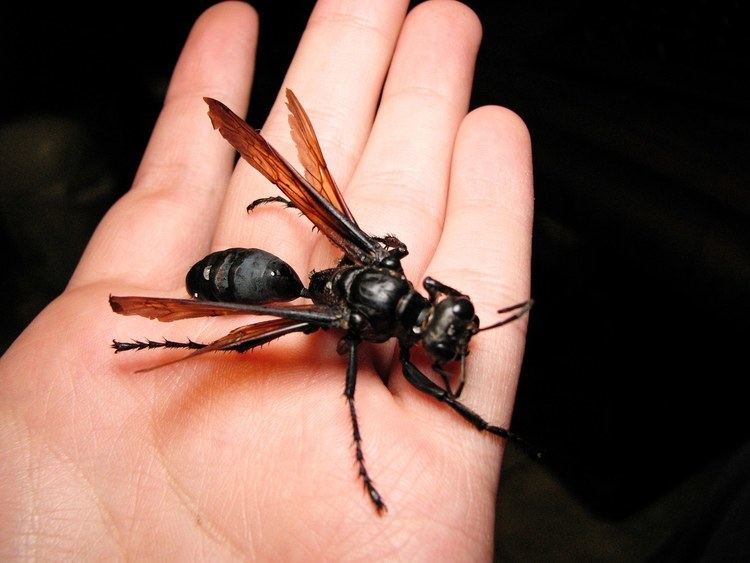
The female tarantula hawk wasp stings and paralyzes a tarantula, then drags the specimen to a specially prepared brooding nest, where a single egg is laid on the spider's abdomen, and the entrance is covered. Sex of the larvae is determined by fertilization; fertilized eggs produce females while unfertilized eggs produce males. When the wasp larva hatches, it creates a small hole in the spider's abdomen, then enters and feeds voraciously, avoiding vital organs for as long as possible to keep the spider alive. After several weeks, the larva pupates. Finally, the wasp becomes an adult and emerges from the spider's abdomen to continue the life cycle.
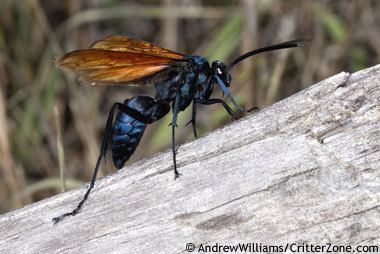
Adult tarantula hawks are nectarivorous. The consumption of fermented fruit sometimes intoxicates them to the point that flight becomes difficult. While the wasps tend to be most active in daytime summer months, they tend to avoid high temperatures. The male tarantula hawk does not hunt; instead, it feeds off the flowers of milkweeds, western soapberry trees, or mesquite trees (females feed on these same plants, as well). Male tarantula hawks have been observed practicing a behavior called hill-topping, in which they sit atop tall plants and watch for passing females ready to reproduce. Females are not very aggressive, in that they are hesitant to sting, but the sting is extraordinarily painful.
Distribution
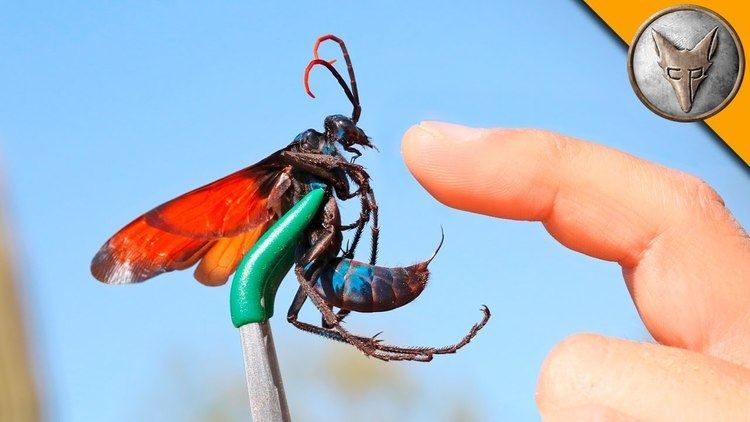
Worldwide distribution of tarantula hawks includes areas from India to Southeast Asia, Africa, Australia, and the Americas. Tarantula hawk species have been observed from as far north as Logan, Utah in the United States, and south as far as Argentina in South America, with at least 250 species living in South America. Eighteen species of Pepsis and three species of Hemipepsis are found in the United States, primarily in the deserts of the southwestern United States, with Pepsis grossa (formerly Pepsis formosa) and Pepsis thisbe being common. The two species are difficult to distinguish, but the majority of P. grossa have metallic blue bodies and reddish antennae, which separates them from P. thisbe. Both species have bright orange wings that become transparent near the tip.
Sting

Tarantula hawk wasps are relatively docile and rarely sting without provocation. However, the sting—particularly that of P. grossa—is among the most painful of all insects, though the intense pain only lasts about five minutes. One researcher described the pain as "…immediate, excruciating, unrelenting pain that simply shuts down one's ability to do anything, except scream. Mental discipline simply does not work in these situations." In terms of scale, the wasp's sting is rated near the top of the Schmidt sting pain index, second only to that of the bullet ant, and is described by Schmidt as "blinding, fierce [and] shockingly electric". Because of their extremely large stingers, very few animals are able to eat them; one of the few animals that can is the roadrunner. Many predatory animals avoid these wasps, and many different insects mimic them, including various other wasps and bees (Müllerian mimics), as well as moths, flies (e.g., mydas flies), and beetles (e.g., Tragidion) (Batesian mimics).
Aside from the possibility of triggering an allergic reaction, the sting is not dangerous and does not require medical attention. Local redness appears in most cases after the terrifying pain, and lasts for up to a week.
State insect of New Mexico
The U.S. state of New Mexico chose a species of tarantula hawk (specifically, P. formosa, now known as P. grossa) in 1989 to become its official state insect. Its selection was prompted by a group of elementary school children from Edgewood doing research on states that had adopted state insects. They selected three insects as candidates and mailed ballots to all schools for a statewide election. The winner was the tarantula hawk wasp.
